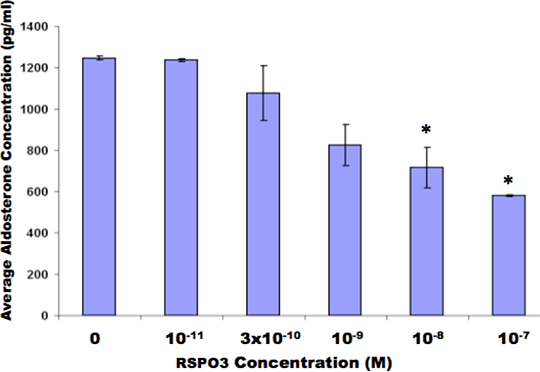Print version
Search Pub Med
Upregulation of leucine-rich repeat containing G protein-coupled receptor 5 (LGR5) and its cognate ligand, RSPO3, in human adrenal zona glomerulosa, and their role in cell proliferation and apoptosis Background: The zona glomerulosa (ZG) of human adrenals has typically sparse aldosterone synthase expression, presumed due to suppression by excess dietary salt.1 Although not traditionally considered regenerative, we recently reported ZG cells with specific gain-of-function somatic mutations (in CTNNB1 (β-catenin), ATP1A1 (Na+,K+-ATPase), or CACNA1D (Cav1.3)) in a common, but frequently overlooked, subset of small aldosterone-producing adenomas.1 An understanding of normal ZG cell turnover might help explain the surprisingly high frequency of benign tumours in an endocrine tissue. Aims: To find, by microarray, genes upregulated in ZG vs zona fasciculata (ZF); to compare, qualitatively, rates of apoptosis and proliferation in these zones; to examine effects on aldosterone production of upregulated genes in the WNT/β-catenin signalling pathway. Methods: RNA from ZG and ZF of 21 human adrenals was isolated by Laser capture microdissection (LCM). The RNA was analysed in an Affymetrix microarray comparison of the two zones. Significant findings were validated by qPCR and immunohistochemistry (IHC). The cognate ligand of LGR5, R-spondin (RSPO3), was used to assess the effect of receptor activation on aldosterone secretion (radioimmunoassay) and the WNT/β-catenin canonical signalling pathway (Cignal TCF/LEF Reporter assay). Pharmacological analysis was performed on dispersed primary adrenal, and immortalised H295R or HAC15 adrenocortical cell lines. Results: The putative stem cell marker, and a key gene for WNT signalling, LGR5, was the most upregulated gene in ZG (x 25.0, P =10-23) vs. paired ZF. RSPO3 (x5.27, P =10-11) and WNT4 (x2.25, P=10-8) were also highly expressed in ZG. IHC confirmed selective localisation of LGR5 in ZG. TUNEL staining showed a high rate of apoptosis in the ZG; Ki67 (proliferation marker) showed some staining. In both primary human adrenal and H295R adrenocortical cells, RSPO3 caused dose-related inhibition of aldosterone secretion (Fig 1). 
Figure 1: H295R cells treated with increasing concentrations of RSPO3. (*= P <0.05, compared to baseline.) Conclusion: Human ZG shows high LGR5 expression and apoptosis rate. The inhibition of aldosterone by RSPO3 points to WNT as a candidate for mediating salt-induced ZG suppression. Developmentally, WNT appears to determine adrenal cell entry into either a secretory or proliferative/apoptotic mode. High ZG cell turnover would confer a selective advantage to cells with constitutive aldosterone production, e.g. following somatic mutation, over cells programmed to divide and die. This may explain the small size and high frequency of aldosterone-producing adenomas arising in ZG. (1) Azizan EA et al, Nat Genet 45:1055, 2013
|


